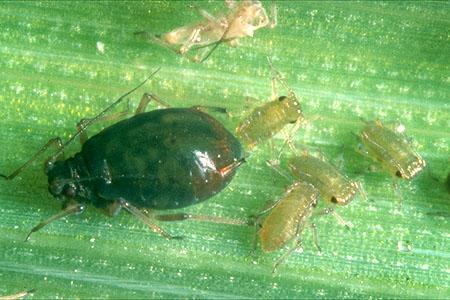Rhopalosiphum padi is a host-alternating aphid – it normally exploits gramimaceous plants (secondary hosts) in summer and returns it its primary woody host (cherry) to complete a sexual generation in the fall. Sexual females (oviparae) lay overwintering eggs on the twigs of cherry which hatch into first-generation asexual females (fundrices) in the spring. By the time the daughters of these fundrices mature, the flush of new growth on the cherry trees hardens and is no longer a suitable food source, so virtually all develop into winged forms (alatae) that disperse to colonize suitable graminaceous plants such as wheat, oats or barley.
Although R. padi has been recorded from several hundred grasses, species that utilize the C4 metabolic pathway (e.g., corn and sorghum) are generally less suitable. However, it may form mixed colonies with other aphids that seem to increase the suitability of these plants for R. padi, as observed on sorghum during heavy infestations of the sorghum aphid. It is important to recognize that many R. padi populations can now skip the sexual generation (holocycle); when winters are sufficiently warm, asexual (anholocyclic) reproduction can continue year-round on graminaceous plants. With the advent of climate change, this is likely to occur at increasingly higher latitudes. Anholocyclic populations of R. padi occur in Oklahoma and possibly in southern Kansas. Rhopalosiphum padi can survive and reproduce at low temperatures; it occurs on wheat later in the fall, and earlier in the spring than other aphids, often while snow is still on the ground. The advent of warmer winters in Europe has resulted in year-round asexual reproduction by R. padi as far north as Poland where it has been recently linked to increased rates of disease transmission in spring-sown cereals.
The bird cherry-oat aphid can be considered a cryptic pest of wheat. Although its feeding causes no chlorosis or other visible damage to wheat plants, heavy infestations can reduce grain quality, protein content and test weight, and even impede protein assimilation by grazing cattle. However, its greatest economic impact results from its role as a key vector of plant viruses, especially Barley Yellow Dwarf Virus (BYDV). Virus infections are more damaging when they occur in early growth stages of the wheat plant and R. padi is well suited for this purpose. Although the hot summer weather in Kansas usually decimates aphid populations, R. padi can temporarily avoid extremes of temperature by descending to feed on the lowest parts of the stalk, at or below ground level. It is also able to feed actively in weather too cold for other aphids such as greenbug, enabling it to effectively colonize seedling wheat quite late into the fall.
